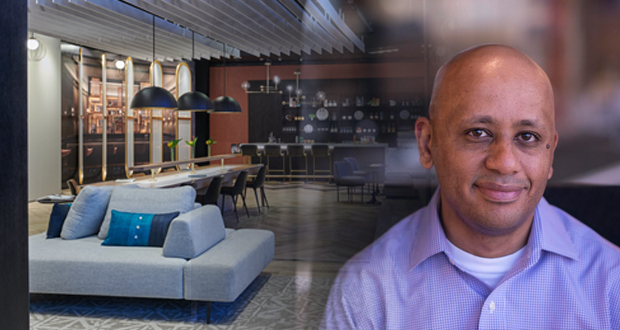At this year’s NYU Investment Conference, Marriott’s Sheraton brand showcased nine new flexible design additions to its portfolio, refreshing the brand for a new generation of travelers, while keeping much-beloved elements to give returning guests a sense of place. Indy Adenaw, vice president and global brand leader for Sheraton Hotels, spoke with LODGING about Sheraton’s updates.
In the United States in particular, guest perception hasn’t been the greatest for Sheraton over the past few years. How are you trying to flip the script?
The Sheraton journey is like our team’s internal journey. First, we were a bit weary and unsure of the brand’s positioning. Then, we started understanding more about Sheraton and fell in love with the brand. We believe our customers will go through that same journey. There are few hospitality brands with which we have grown up with and feel familiar. Sheraton has that familiarity globally, and it’s an honor to bring that to the United States.
What has your approach been?
Our first idea was to weave one thread throughout our work. Instead of solving one problem at a time, we connected every aspect of the reimagining together. When doing this, we tried to be thoughtful and put the business first. Also, Sheraton has seen marketing challenges in the past, and we now understand how to change that and create an experience that makes sense to both guests and owners. We want owners to feel confident in knowing the product before marketing, and we’re remarkably proud of what we’re delivering.
What has been guest response to these new spaces?
We’ve learned to respect Sheraton’s roots and treat the brand with care. Not only has that mindset been important to us, but it’s also been important to everyone else. The space resonates with guests because it provides a sense of community. The program we’ve created and designed is warm, accepting, and open, but it also caters to different groups of customers. Our owners and operators have been pleasantly surprised by the support from guests behind every idea.
How can you make sure Sheraton is getting the attention it deserves when competing with Marriott’s many, many other brands?
Sheraton is the portfolio’s priority and has always been important from a financial and operational perspective. The brand has 500 units in the pipeline. We’ve always felt good about where Sheraton is in the Marriott portfolio, and we’re pushing that balance and comprehension.
What new design element do you enjoy most?
From a design perspective, hotels usually have separate spaces for separate activities—checking in, meetings, and getting a bite to eat are all done differently. Now, people work while they eat and meet while they drink; there aren’t any artificial borders placed into what we do, so we’ve blurred those spaces. We also have elegant transitions. For example, a coffee station is busy in the morning and empty in the evening, but it’s the opposite for a bar. We can transition into both operations elegantly and have it feel like a piece of art with the principles we carry across hotels.
Additionally, a gathering place doesn’t just become a gathering place with one community table or two meeting rooms. It’s in how these spaces interact. We’ve been working closely with our first 10 to 12 hotels to ensure that they get this right. The vast majority of owners undergoing PIPs and renovations want to implement some of these ideas. We’re creating the right gathering space in a manner that makes us valuable with our partners and operators. We believe in these principles and are building on our most important pieces.











